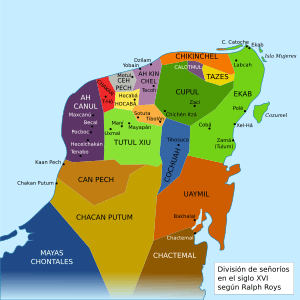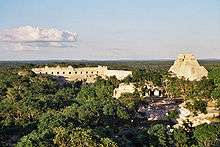Tutul-Xiu
Kuchkabal Tutul Xiu | |||||||||
|---|---|---|---|---|---|---|---|---|---|
| 1441–1547 | |||||||||
 Kuchkabals of Yucatan after 1461. | |||||||||
| Capital | Maní | ||||||||
| Common languages |
Official language: Yucatec | ||||||||
| Religion | Maya religion | ||||||||
| Government | Monarchy | ||||||||
| Halach Uinik | |||||||||
| Historical era | post classic / Early Modern | ||||||||
• Established | 1441 | ||||||||
• Disestablished | 1547 | ||||||||
| |||||||||
Tutul-Xiu, also Tutul Xiues or Mani, was the name of a Mayan chiefdom of the central Yucatán Peninsula with capital in Maní, before the arrival of the Spanish conquistadors in the sixteenth century.[1]
History
Before The League Of Mayapan
In the Seventh century the Tutul Xiues migrated to Yucatán. There their leader Ah Suytok Tutul Xiu, nicknamed Chac Uitzil Hun, founded Uxmal. The date that this happened is disputed by a codex from Tizimin, and another from Mani. In 869 Ah Mekat Tutul Xiu ruler of the Tutul xius moved to Uxmal from Nonohual. Nonohual's location is unknown, but was probably in Peten, it also might have been another name for Potonchán in Tabasco or Tula. The Tutul Xius were the main group of people forcing the Itzas out of Chichen Itza.

The end of the League
In 1441 the league had a civil war betweenthe Cocom and Tutul Xiues. The rest of the league took advantage of the war, and rebelled. By 1461 The League of Mayapan had been completely disintegrated into seventeen Kuchkabals.
Independence
After the war between the Tutul xiues and the Cocom the two managed to have peaceful relations until 1535. In 1535 the Cocom went to the ruins of Chichen Itza to perform a ceremony. They were ambushed by the Tutul Xiues. After that there was heavy conflict between the two.
Organization
Normally each Kuchkabal had a capital where the ruler and supreme priest lived. The ruler was called a Halach Uinik . Each Kuchkabal was divided into several municipalities called "Batalib" which in turn were governed by officials called " Batab "who were usually relatives of the Halach Uinik. Each Batab, was the military leader of its population.

On the religious side, after Halach Uinik, was the Ah Kin May, and the regular priests Ah Kin (meaning coming from the Sun). Also there was a sacrificial priest called "Ah Nacom".
European contact
In the final conquest of Yucatán during the late 1540s Tutul Xiu was heavily beaten and formed an alliance with the Spaniards.
References
- ↑ Roys, Ralph Loveland (1957). The political geography of the Yucatan Maya. Carnegie Institution of Washington. p. 61. Retrieved 5 July 2012.